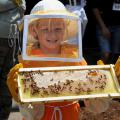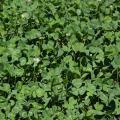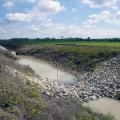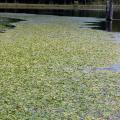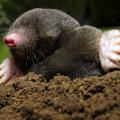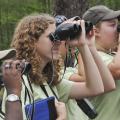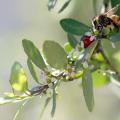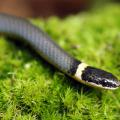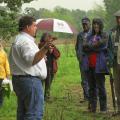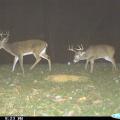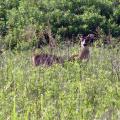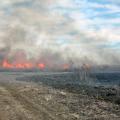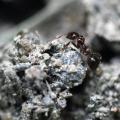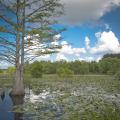Extension Outdoors from 2014
A fertilization program can greatly increase fish production in fishing ponds.
Adding nutrients stimulates the growth of the microscopic plants, or algae, that feed the small animals that feed the fish. Fertilization can increase fish production by three to four times, resulting in more fish, bigger fish or both in properly managed ponds. Also, these tiny plants can shade the bottom and prevent aquatic weeds from taking over.
Wild hogs continue to be a plague throughout Mississippi, occupying about half of the state’s land area.
A farmer recently said, “I wish I had a deer problem.” His statement summed up the hog problem very well. There’s no doubt that deer can cause a lot of damage to certain crops, but that damage is minor compared to the destruction wild hogs can cause. What’s more, hog damage is no longer limited to farmland. You may even see them in your back yard!
MISSISSIPPI STATE -- The days are getting longer, and the temperatures are warming up. Spring is almost here, and soon the birds will arrive.
More than 200 bird species migrate northward every spring from their wintering grounds in the southern U.S. and Central and South America.
MISSISSIPPI STATE -- If thoughts of keeping bees have been buzzing in your head, you’re not alone.
“Beekeeping can be a fascinating hobby, a profitable sideline, or a full-time occupation,” said Jeffrey Harris, beekeeping specialist with the Mississippi State University Extension Service.
Mississippi is home to approximately 12 full-time commercial beekeepers, 35 part-time honey producers, and several hundred hobbyists. The state ranks twenty-eighth in the nation in honey production, with about 2.25 million pounds of honey produced each year.
By James E. “Jim” Miller
Professor Emeritus, Department of Wildlife Fisheries and Aquaculture
MSU Extension Service
MISSISSIPPI STATE – Offering feed to wildlife is a trend gaining traction in newspaper outdoor columns, outdoor magazines, catalogs, ads and campfire discussions, but the practice can be harmful to wildlife.
In the South, springtime means turkey hunting, bass fishing and preparing wildlife food plots.
Food plots are the most affordable way for hunters to provide high-quality forages for the deer, turkey and other wildlife on the property.
A productive, warm-season food plot can generate up to 4,000 pounds of high-quality forage per acre -- that’s a lot of bang for the buck.
MISSISSIPPI STATE – September and the opening of dove season are several months away, but planting food plots in spring allows plants to reach maturity before the dove hunting season begins.
Whether you’re planting dove plots for personal or business use, they need proper preparation.
“Doves really depend on a lot of foods that are in agricultural fields and in open meadow fields,” said Jeanne Jones, wildlife ecologist at Mississippi State University. “They are weak scratchers, so they need a certain amount of bare ground.”
By Beth Poganski
MSU Extension Service
MISSISSIPPI STATE -- Mississippi might not have been ranked the healthiest or the wealthiest state in 2013, but if there were a ranking for water resources, Mississippi would be near the top of the list.
Several factors place Mississippi in the very fortunate situation of having what much of the world does not: water.
The birds are singing, the flowers are blooming, and yes, the weeds are starting to grow in your fishing pond. Don’t let them get out of hand! Start your weed management program early, before the problem becomes too difficult to treat.
Prevention is the best way to avoid weed problems. Shallow areas where light reaches the pond bottom are ideal for the growth of rooted aquatic weeds. Deepening pond edges so that the water depth quickly reaches 3 feet helps reduce weeds. For safety, make the slope 3:1, or one foot deeper for every three feet farther from shore.
MISSISSIPPI STATE -- You hardly ever see them, but their small, cylindrical bodies can wreak havoc on your lawn. Each year, Mississippi homeowners spend countless hours and hundreds or thousands of dollars attempting to rid their yards of these solitary insectivores.
The inviting, safe environment of residential lawns and gardens may create an annual mole problem. Understanding mole behavior, trapping early and vigilantly, and modifying landscapes to discourage digging will mean less time dealing with moles and more time enjoying your backyard.
MISSISSIPPI STATE -- Spring is the time to get outside and enjoy soft, warm breezes and glorious sunshine before summer’s heat forces us to seek shelter indoors. One way to connect with nature and awaken your winter-weary soul is getting to know your feathered neighbors.
MISSISSIPPI STATE -- Gardening season is in full swing, and rain barrels are displayed for sale in local gardening stores. Rain barrels are systems that collect rainwater that would otherwise be lost into city sewers. The rainwater can be used to keep tomatoes, herbs and other treasured garden plants flourishing.
The Environmental Protection Agency estimates that 40 percent of total household water use during the summer is for lawn and garden watering. Rain barrels are easy ways to both conserve water and cut your water bill.
MISSISSIPPI STATE – Twice a year, I get the urge to do something “wild” in my backyard. Now, granted, this is something I could do year-round in my neck of the woods, but the sounds of the birds and the bees twittering and buzzing away -- usually in the spring and fall -- really get me excited.
My foray into the wild side begins with identifying what my backyard already has to offer in the way of food, water, shelter and a place to raise young. My venture: to fill in the gaps.
MISSISSIPPI STATE -- Despite most people’s fears, snakes are an important part of our natural world and are also helpful to us in many ways.
All snakes are predators, meaning they feed on other animals. Snakes kill and eat rats, mice, moles, insects and other pests that can damage crops and property or spread disease. Because snakes can get into places that other predators cannot or will not go, they can capture rodents that threaten livestock feed or farming equipment and supplies.
By Daryl Jones
Natural Resource Enterprises
MSU Extension Service
MISSISSIPPI STATE -- Outdoor recreation in Mississippi provides income not only for those who own the land, but also for the state as a whole.
That’s because economic impact is not limited to the first person who receives money for goods or services. Every dollar spent has direct effects, but it also has indirect and induced effects.
MISSISSIPPI STATE -- A camera that began as a cool gadget for photographing bucks and monitoring food plots or game trails has become an important survey instrument for managing deer populations.
White-tailed deer management involves more than managing habitats and planting supplemental food plots. Proper deer management requires managing populations as well. Deer managers can use game cameras to estimate deer population characteristics and develop good harvest management strategies. This will help maintain a healthy and productive deer herd.
By James E. “Jim” Miller
Professor Emeritus, Department of Wildlife Fisheries and Aquaculture
MSU Extension Service
MISSISSIPPI STATE -- Wildife is too important to be owned by an individual.
MISSISSIPPI STATE – A well-managed prescribed burn is an important tool in a landowner’s kit.
Yet news stories about wildfires often discourage landowners from using prescribed burning as a management tool. Prescribed burning is a useful and very valuable management option on public and private lands. Prescribed burning can benefit a variety of wildlife species and are necessary in fire tolerant ecosystems, such as longleaf pine forests and coastal savannas.
MISSISSIPPI STATE -- Fire ants are more than aptly named, given the reddish-orange color of their bodies and the painful, burning sting they can give.
Fire ants were unintentionally introduced to the United States from South America. The first documented release of fire ants occurred near Mobile, Alabama around 1918, and by the late 1930s, most of Mississippi had them.
Fire ants are very small and aggressive. When disturbed, they swarm, bite and sting, producing a painful or itchy pustule within hours.
MISSISSIPPI STATE -- A common question in all county Extension offices this time of the year is, “Will the weeds in my pond hurt my fish?” As the water in ponds warms up, the vegetation starts growing.
Is vegetation growing in a pond a problem for the fish? Not necessarily.


